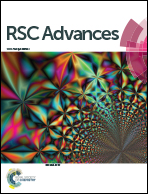A “turn-off” fluorescent sensor for the selective and sensitive detection of copper(ii) ions using lysozyme stabilized gold nanoclusters†‡
Abstract
In this contribution, we have developed a simple, environmentally friendly fluorescent turn-off sensor for the detection of copper (Cu2+) ions in aqueous solution by using lysozyme stabilized gold nanoclusters (Lys-AuNCs) as a fluorescent probe. Since lysozyme acted as both a reducing and stabilizing agent, the use of other external reducing or stabilizing agents was averted in the preparation of Lys-AuNCs. High resolution transmission electron microscopy (HR-TEM) results revealed that Lys-AuNCs are mono-dispersed spherical particles with an average particle size of 2.5 ± 0.3 nm. Lys-AuNCs exhibit strong fluorescence and emit red photoluminescence under illumination with ultraviolet light. The emission intensity of Lys-AuNCs decreased linearly upon the addition of increasing concentrations of Cu2+ ions in a wide range of 0.40 × 10−7 mol dm−3 to 4.00 × 10−7 mol dm−3 and the corresponding linear plot had a correlation coefficient of 0.9976. The limit of detection for this method was calculated as 9.00 × 10−9 mol dm−3 (S/N = 3). Lys-AuNCs exhibit good selectivity towards the selective determination of Cu2+ ions even in the presence of 100-fold higher concentration of common interfering cations. To further evaluate the analytical performance of this sensing system, the concentrations of Cu2+ ions were determined in real water samples using tap water, drinking water and sea water.


 Please wait while we load your content...
Please wait while we load your content...